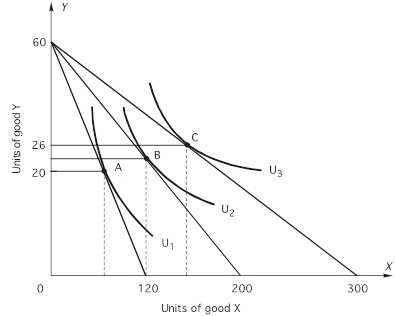 The price of Y is $10.According to the above figure, if the price of X is $5, what combination of X and Y will a utility-maximizing consumer choose?
The price of Y is $10.According to the above figure, if the price of X is $5, what combination of X and Y will a utility-maximizing consumer choose?
A. 120X, 250Y
B. 200X, 620Y
C. 80X, 20Y
D. 120X, 620Y
E. none of the above
Answer: C
You might also like to view...
The national debt is a stock of IOUs created by the summation of annual deficit and surplus flows.
Answer the following statement true (T) or false (F)
Suppose the economy is in long-run equilibrium. If there is a sharp decline in government purchases combined with a significant increase in immigration of skilled workers, then in the short run,
a. real GDP will rise and the price level might rise, fall, or stay the same. In the long-run, real GDP will rise and the price level might rise, fall, or stay the same. b. the price level will fall, and real GDP might rise, fall, or stay the same. In the long-run, real GDP and the price level will be unaffected. c. the price level will rise, and real GDP might rise, fall, or stay the same. In the long run, real GDP will rise and the price level will fall. d. the price level will fall, and real GDP might rise, fall, or stay the same. In the long run, real GDP will rise and the price level will fall.
Suppose that in the year 2015 our national debt were $8 trillion and our budget deficit were $250 billion. If a plan to gradually reduce the deficit and to balance the budget in the year 2025 were successful, make an estimate of the national debt in 2025.
What will be an ideal response?
When the economy is producing its potential output, an increase in government spending must necessarily reduce some component of private spending. This phenomenon is called:
A. fiscal policy. B. crowding out. C. the multiplier effect. D. entitlement spending.